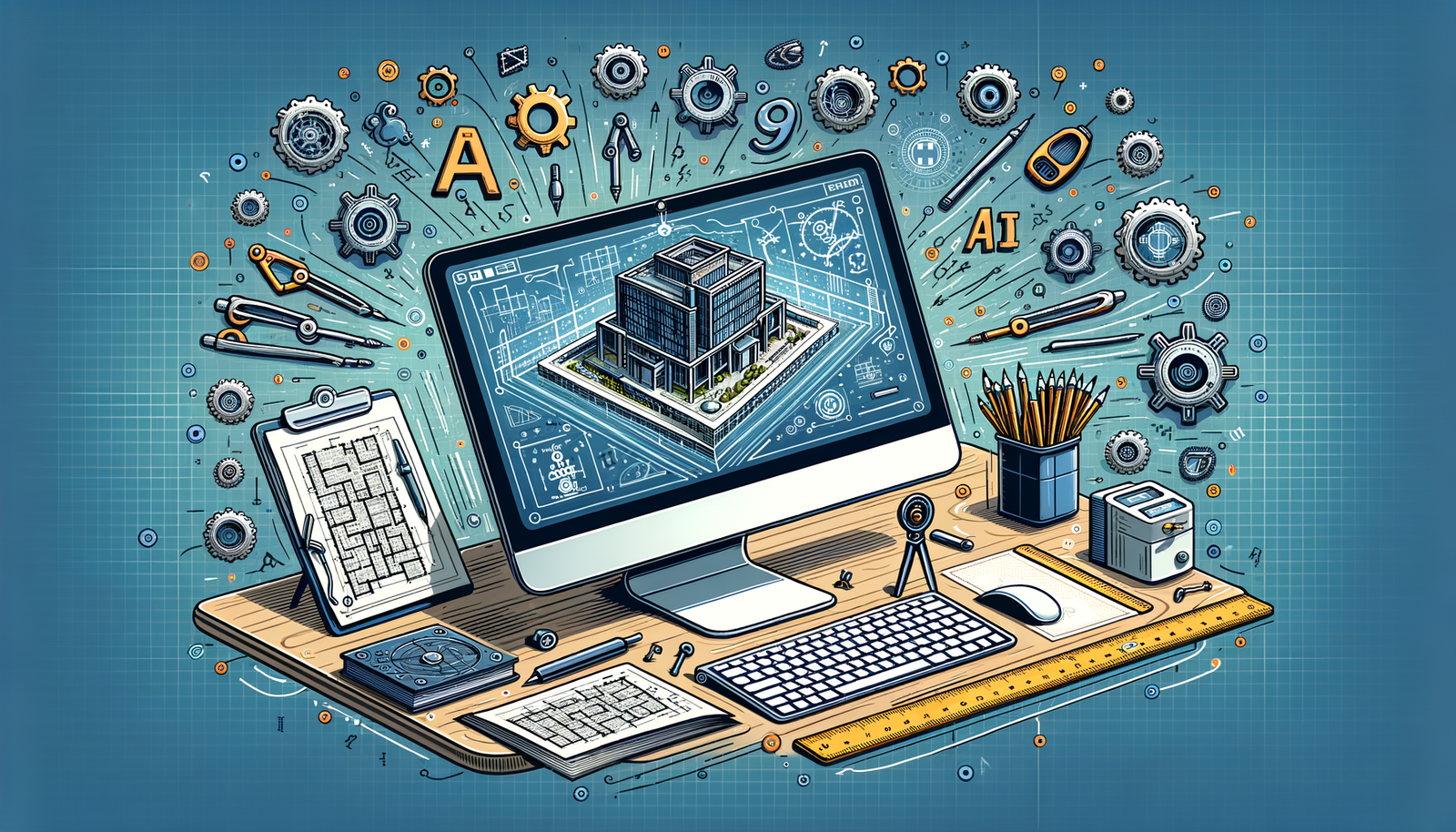Your Cart is Empty
Customer Testimonials
-
"Great customer service. The folks at Novedge were super helpful in navigating a somewhat complicated order including software upgrades and serial numbers in various stages of inactivity. They were friendly and helpful throughout the process.."
Ruben Ruckmark
"Quick & very helpful. We have been using Novedge for years and are very happy with their quick service when we need to make a purchase and excellent support resolving any issues."
Will Woodson
"Scott is the best. He reminds me about subscriptions dates, guides me in the correct direction for updates. He always responds promptly to me. He is literally the reason I continue to work with Novedge and will do so in the future."
Edward Mchugh
"Calvin Lok is “the man”. After my purchase of Sketchup 2021, he called me and provided step-by-step instructions to ease me through difficulties I was having with the setup of my new software."
Mike Borzage
Automated Detail Generation: Transforming Architectural CAD with AI and Advanced Design Technologies
April 15, 2025 7 min read


Importance of Detailed Drawings
In the realm of architecture, detailed drawings serve as the essential bridge between conceptual designs and tangible structures. They are not mere technical illustrations; they are the precise language through which architects communicate their vision to builders, contractors, and stakeholders. The intricacies captured in these drawings convey the architectural intent, ensuring that every nuance of the design is understood and properly executed. Without meticulous details, the risk of misinterpretation increases, potentially leading to construction errors, increased costs, and compromised project outcomes. Detailed drawings impact construction accuracy by providing exact specifications for materials, dimensions, and assembly methods, thus playing a pivotal role in the successful realization of architectural projects.
Evolution from Traditional to Automated Methods
The journey from traditional drafting to today's automated methods reflects a significant technological evolution in architectural practices. Traditionally, architects relied on manual drafting techniques, painstakingly creating detailed drawings by hand. This process was time-consuming and prone to human error, often requiring repetitive tasks that could hinder the creative flow. The advent of computer-aided design (CAD) revolutionized this landscape by introducing tools that enhanced precision and efficiency. Early CAD systems allowed for digital drafting, reducing physical labor and improving accuracy. However, initial benefits were still limited by the requirement for manual input for each detail. Over time, advancements in technology have led to the development of automated detail generation, where systems can generate complex details based on predefined parameters. This evolution marks a significant leap from manual creation to intelligent automation, reshaping how architects approach the detailing phase of design.
Defining Automated Detail Generation
Automated detail generation in CAD refers to the use of advanced software tools that can autonomously create detailed architectural drawings based on input parameters and design intentions. This process involves leveraging algorithms and computational methods to produce intricate details without manual drafting for each element. Current capabilities of automated detail generation include the ability to generate components like joints, connections, and fixtures automatically, adapting to changes in the overall design seamlessly. Applications of this technology span from residential construction to complex commercial projects, enabling architects to maintain consistency and accuracy across their work. By defining rules and standards within the software, architects can ensure that the generated details align with specific project requirements and compliance regulations, thus enhancing both efficiency and quality in the design process.
Parametric and Generative Design
Parametric and generative design are foundational technologies enabling automated detail generation in modern architectural CAD systems. Parametric modeling allows architects to define relationships between different design elements through parameters, so changes in one aspect automatically adjust related components. This capability is crucial for detail automation because it means that intricate parts of the design can adapt dynamically as the overall model evolves. For instance, if the size of a structural beam changes, the connections and supporting details adjust accordingly without manual intervention. Generative design takes this a step further by using algorithms to explore a vast array of design possibilities within set constraints. Examples of generative algorithms include those that optimize material usage, structural performance, or aesthetic criteria. These algorithms can produce innovative and efficient designs that might not be immediately apparent through traditional methods, thus enhancing creativity and functional optimization in detail creation.
Artificial Intelligence and Machine Learning
The integration of artificial intelligence (AI) and machine learning into architectural CAD has significantly advanced automated detail generation. AI plays a role in recognizing patterns within design data, allowing the software to predict and generate appropriate details based on previous projects or established standards. Machine learning models can learn from vast datasets of architectural details, enhancing detail accuracy and variety. For example, a machine learning model can analyze successful connection details from numerous past projects and apply the most suitable solutions to new designs. This capability not only speeds up the design process but also introduces smarter, more reliable details that have been validated through historical performance. By continuously learning and adapting, AI-driven tools help architects produce higher-quality designs with reduced effort.
Integration with Building Information Modeling (BIM)
The synergy between Building Information Modeling (BIM) and automated detail generation is transforming architectural workflows. BIM serves as a comprehensive digital representation of a building's physical and functional characteristics, providing a shared knowledge resource for all stakeholders. When automated detail generation is integrated with BIM, it allows for a seamless flow of information between different stages of design and construction. This integration streamlines workflows through integrated platforms, enabling architects to update designs in real-time and have the detailed elements adjust automatically. The interoperability between BIM and automated detailing ensures that every modification is accurately reflected throughout the model, reducing errors and omissions. This integrated approach enhances collaboration among project teams and contributes to more efficient and coordinated project delivery.
Increased Efficiency and Productivity
Automated detail generation significantly boosts efficiency and productivity in architectural design. By reducing the time spent on repetitive detail tasks, architects can allocate more resources to creative and complex aspects of projects. Automation allows for faster iteration and design modifications, as changes to the main design are automatically propagated to the detailed elements. This rapid adaptability is crucial in meeting tight project deadlines and accommodating client feedback. The efficiency gains from automation also translate into cost savings, as less time is required for manual detailing and corrections. Moreover, teams can handle larger and more complex projects without proportionally increasing workload, thanks to the scalability provided by automated systems.
Enhanced Accuracy and Consistency
One of the paramount benefits of automated detail generation is the enhancement of accuracy and consistency across architectural projects. By minimizing human error in detail creation, automation ensures that every component adheres to predefined standards and specifications. This uniformity is essential for maintaining quality and compliance with building codes and regulations. Automated systems can consistently apply the same rules and calculations, reducing discrepancies that might occur with manual drafting. Maintaining uniform standards across projects not only improves the integrity of individual designs but also strengthens the overall reputation of architectural firms by delivering reliable and precise work consistently.
Facilitating Creativity and Focus on High-Level Design
Automated detail generation empowers architects to concentrate on the conceptual and innovative aspects of their work by alleviating the burden of routine detailing tasks. Allowing architects to focus on higher-level design encourages the exploration of bold ideas and the development of unique architectural solutions. Automation tools unlock new creative possibilities by handling the intricate details that might otherwise constrain imaginative thinking. With the support of automation, architects can experiment with complex forms and structures, knowing that the detailed aspects will be managed efficiently. This synergy between technology and creativity leads to designs that are both aesthetically compelling and functionally sound.
Current Limitations and Obstacles
Despite the significant advancements in automated detail generation, several limitations and obstacles persist. Technical barriers in achieving complex detail automation stem from the challenges of programming software to handle the vast variability and uniqueness of architectural designs. Some intricate details require a level of intuition and contextual understanding that current algorithms may not fully replicate. Integration challenges with existing workflows and software also pose obstacles, as firms may use a combination of legacy systems and new tools that do not seamlessly communicate. Additionally, there may be resistance to change within organizations, where professionals are accustomed to traditional methods and may be hesitant to adopt new technologies that alter established processes.
Future Technological Advancements
The future of automated detail generation is poised for significant enhancements driven by emerging technologies. Developments in AI and machine learning are expected to lead to smarter, more adaptable systems capable of handling greater complexity and nuance in designs. Potential improvements include more advanced machine learning models that can understand context and make decisions akin to human reasoning. Additionally, advancements in algorithm development may introduce more sophisticated generative design tools that can optimize for multiple criteria simultaneously. Integration with technologies like cloud computing and the Internet of Things (IoT) could enable real-time data exchange and collaboration across global teams, further enhancing the capabilities and reach of automated detailing tools.
The Evolving Role of Architects
As automation becomes more prevalent in architectural design, the role of architects is evolving. Shifting responsibilities with increased automation mean that architects may spend less time on manual drafting and more on strategic decision-making, client interactions, and innovation. Balancing creativity with technological tools requires architects to develop new skills, such as proficiency with advanced software and an understanding of algorithms and data analysis. The human touch remains indispensable, as architects provide the vision and judgment that guide projects. Embracing automation allows architects to enhance their work rather than replace it, leading to a more efficient and dynamic practice that leverages both human creativity and technological prowess.
Summary of Key Points
Automated detail generation in architectural CAD represents a significant advancement in design technology, offering profound impacts on efficiency, accuracy, and creativity. The importance of detailed drawings lies in their role in conveying architectural intent and affecting construction outcomes. The evolution from traditional manual methods to automated systems has been enabled by technologies such as parametric and generative design, AI, and integration with BIM. Benefits include increased productivity through reduced repetitive tasks, enhanced accuracy by minimizing human error, and facilitating creativity by allowing architects to focus on high-level design aspects. Despite current limitations and obstacles, ongoing technological advancements promise to further enhance automated detailing capabilities.
Significance in Modern Architectural Practices
Automation is transforming the architectural landscape by redefining workflows and expanding the possibilities of design. In modern practices, the adoption of automated detail generation is becoming essential for staying competitive and meeting the demands of complex projects. It enables firms to deliver high-quality designs more efficiently and to adapt quickly to changing requirements. The integration of automation in architectural processes contributes to more sustainable and innovative solutions, as architects can explore a wider range of options without the constraints of manual detailing. This transformation reflects a broader shift towards digitization and intelligent systems within the construction industry.
Looking Ahead
Anticipated developments in technology suggest that automated detail generation will continue to grow in sophistication and utility. The ongoing relationship between architects and design software is expected to become more collaborative, with tools that not only execute tasks but also provide insights and suggestions. Architects will likely assume roles that blend creative leadership with technical expertise, harnessing automation to push the boundaries of design. Embracing these advancements will be key to addressing future challenges in sustainability, urbanization, and resource management. As automation tools evolve, they will be integral in helping architects create innovative, efficient, and impactful designs that shape the built environment for generations to come.
Also in Design News

Harnessing Distributed Ledger Technology for Secure and Transparent Design Collaboration
May 06, 2025 11 min read
Read MoreSubscribe
Sign up to get the latest on sales, new releases and more …




